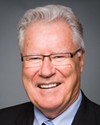You could still enroll: we take people up to 52. We actually have recruits at the recruit school in Saint-Jean who Monsieur Bachand has met who are 50, 51, and 52. They change the dynamic of the recruiting system dramatically.
So you're right, we have people coming through, and that in itself is presenting its own challenges. What you really want as a target audience is 18 to 25, because at the end of it, when you're out there and you're humping a rucksack, it's a young person's game in many cases. It gets tougher when you get as old as I am. I've still got to do it. I did my PT test two weeks ago.
But I come back to the second issue, which is really fundamental to this discussion, and that is the training pipeline. What you speak to is what we call those on the basic training list. That number has expanded over the last number of years because we recruited so many people.
On the one hand, I've had great recruiting success. We recruited this year some 7,700 and some figures, grosso modo. The last time we had to do that successfully from a Canadian Forces perspective was the Korean War. So it's great kudos to the men and women in uniform who've recruited everybody, but then it's that training pipeline. So what are we doing?
As one of the honourable members will tell you, one of the things the air force has done is cut back the training required to train a pilot, because what was required was four years. It speaks to your issue. How do you keep someone motivated who came in wanting to fly for four years to cut that back? That's then challenged with the issue of safety, due diligence, with ensuring that people are trained effectively.
What we are doing--if I can give you some examples to kind of cut that down--is we partnered a year and a half ago with five community colleges across the country to start doing some of our training. We do not have enough people to do the training, which is why we've hired people on class B from the regular forces to come back and do the training for two or three years in many cases.
You'll find them in Saint-Jean, across the country in Wainwright, at any training establishment, because our training capacity is limited. That's where the question is. How are we going to ensure that we reduce the amount of time to an increasing number of folks coming in? We've partnered with five community colleges, and we're expanding the program so they do the training--geomatics training, cooks training--so we push people out.
We have spoken to a number of those in charge at community colleges, extremely happy with the program from our perspective and from theirs. It has actually assisted in the dress and deportment at the community colleges, because we have all of our men and women in uniform go to college in this program dressed in uniform. They actually move around like military soldiers, sailors, airmen, and airwomen. So it's actually added to that program as well.
But it is a critical challenge right now. That number is high, and how do you reduce the training pipeline without sacrificing the standards and the quality? You can always be more efficient, but when you touch effectiveness becomes the real challenge.






